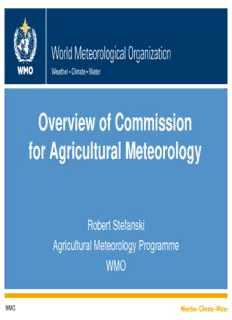
Overview of Commission for Agricultural Meteorology PDF
Preview Overview of Commission for Agricultural Meteorology
Overview of Commission for Agricultural Meteorology Robert Stefanski Agricultural Meteorology Programme WMO WMO World Meteorological Organization United Nations agency for weather, climate, hydrology and water resources and related environmental issues. 191 Members from National Meteorological and Hydrological Services (NMHS) – Newest Member South Sudan (Dec 2012) 10 major scientific & technical programmes (Secretariat) 8 Technical Commissions advise & guide activities of programmes (Experts) 6 Regional Associations involved in implementation 2 3 WMO Technical Commissions Commission for Aeronautical Meteorology (CAeM) Commission for Agricultural Meteorology (CAgM) Commission for Atmospheric Sciences (CAS) Commission for Basic Systems (CBS) Commission for Climatology (CCl) Commission for Hydrology (CHy) Commission for Instruments and Methods of Observation (CIMO) Joint WMO-IOC Commission for Oceanography and Marine Meteorology (JCOMM) World Meteorological Organization Congress – every 4 years (all members) – first ever Extraordinary Session in 2012 - GFCS Executive Council – every year (37 members) – 1 P, 3 VP, 6 Pres of RAs, 27 PRs, PTCs attend Regional Association Sessions- every 4 years Technical Commission sessions – every 4 years Commission for Agricultural Meteorology (CAgM) – Terms of Reference (1) Support applications of meteorology to management of agriculture, livestock, forestry, rangelands and fisheries sectors; Assist Member countries in developing/establishing their agrometeorological services particularly on: Operational use of knowledge concerning weather and climate for sustainable agricultural management through conservation and better use of natural resources; Use of weather and agrometeorological observations, forecasts and warnings for operational purposes; Commission for Agricultural Meteorology (CAgM) – Terms of Reference (2) Use of climate observations and predictions; Adaptation to climate variability and change (developing countries); Combating unfavourable influences of weather and climate on agricultural subsectors, including weather-related pests and diseases; Protection of agricultural produce in storage/transit against damage due to direct and indirect influences of weather and climate; Commission for Agricultural Meteorology (CAgM) – Terms of Reference (3) Improve coordination and collaboration mechanisms with users of weather and climate information in agricultural subsectors & liaise actively with weather and climate service providers; Formulate data and information requirements for agricultural purposes; Foster development and use of effective communication methods for acquiring and disseminating agrometeorological information, advice and warnings to agricultural subsectors and getting feedback; Promote a better understanding of the interactions and impacts of weather and climate in regards to drought and desertification; COMMISSION FOR AGRICULTURAL METEOROLOGY President: Byong Lee, Vice-President: Federica Rossi Management Group Advisors: S. Orlandini (Italy-RA VI ) (MG) G. Zhou (China-RA II) FOCUS AREAS (FA) FA 1 FA 2 FA 3 FA 4 Operational Science and Natural Hazards Capacity Agricultural Technology for and Climate Development in Meteorology Agricultural Change/Variability Agricultural Meteorology In Agriculture Meteorology Chair: N. Chattophday Chair: O. Brunini Chair: R. Stone Chair: E. Mateescu (India-RA II) (Brazil-RA III) (Australia-RA V) (Romania-RA VI) Co-chair: D. Diarra Co-chair: H. Shannon Co-chair: R. Desjardins Co-chair: J. Ukeje (Mali-RA I) (USA-RA IV) (Canada-RA IV) (Nigeria-RA I) CAgM Focus Area 1 – Operational Agricultural Meteorology ET 1.1 - Livestock, Poultry, and Inland Fisheries ET 1.2 - Agromet Products ET 1.3 - Forestry (Fire Weather, Fire danger rating) TT 1.1 - Publication on Case Studies TT 1.2 - Task Team on Guidelines for Developing Agricultural Weather Bulletins Joint CAgM–JCOMM Task Team on Weather, Climate and Fisheries
Description: